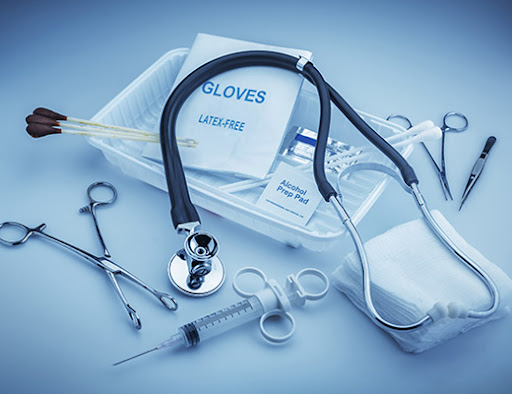As winter season begins, it brings not only the beauty of snow and cold winds but also a variety of health challenges. The harsh cold weather can increase certain medical conditions, increase the risk of falls and accidents, and complicate respiratory issues. Whether you’re dealing with acute injuries or managing chronic conditions worsened by the cold, having the proper medical equipment ensures you can handle any situation that may come your way. In the following paragraphs we have enclosed the essential tools and equipment you should have during the winter months to stay safe, healthy, and prepared for cold weather health challenges. As with the right medical equipment, you can effectively address these health concerns and stay prepared for the colder months.
1. Thermometers for Early Detection of Fever
When the temperature plummets, our bodies are at risk to illnesses such as flu, colds, or respiratory infections. Monitoring your temperature regularly is a key step in identifying illnesses early. A digital thermometer is an essential tool to have during the winter season. It provides fast and accurate readings, allowing you to catch fevers early and take action before symptoms worsen. Regularly checking your body temperature, particularly during the cold and flu season, can help you stay on top of your health and ensure that any illness is addressed quickly. Many thermometers available today offer instant readings, are easy to use, and have memory functions that allow you to track temperature fluctuations over time.
2. Blood Pressure Monitors for Cardiovascular Health
Cold weather places additional stress on the cardiovascular system, as the body works harder to maintain its core temperature. Blood vessels constrict in cold weather, raising the risk of heart attacks or strokes, especially for those who suffer from high blood pressure or other cardiovascular conditions. To prevent complications, using a blood pressure monitor regularly is an effective way to stay on top of your cardiovascular health. A reliable home blood pressure monitor helps you keep track of any changes or irregularities, checking timely intervention when necessary. Managing your blood pressure becomes even more critical during the winter months, when extreme temperatures can cause sudden fluctuations.
3. Oxygen Concentrators for Respiratory Support
Cold weather can cause respiratory difficulties, particularly for individuals with pre-existing conditions like asthma, COPD (chronic obstructive pulmonary disease), or other chronic lung diseases. The cold, dry air can irritate the airways, making it harder to breathe and potentially triggering asthma attacks or shortness of breath. For those with chronic respiratory conditions, an oxygen concentrator is an indispensable tool. These devices provide a continuous flow of oxygen, helping individuals maintain proper oxygen levels and avoid complications associated with low oxygen saturation. If you or a loved one struggles with breathing difficulties, having an oxygen concentrator on hand can provide relaxation, knowing that you’re prepared to manage any respiratory concerns that arise during the winter season.
4. Heating Pads for Joint and Muscle Relief
For those who suffer from arthritis or other joint conditions, winter can be particularly challenging. The cold weather can cause joints to stiffen, leading to discomfort, pain, and reduced mobility. Muscle cramps and tightness can also become more noticeable in colder temperatures. A heating pad is a simple yet effective way to provide relief from these winter-related aches and pains. Heat therapy improves blood flow to the affected areas, helping to relax muscles, reduce stiffness, and alleviate pain. This is especially beneficial for people suffering from chronic joint pain or muscle strain caused by the colder weather. Heating pads are widely available and easy to use, making them a must-have in any home during the winter months.
5. Mobility Aids to Prevent Slips and Falls
Winter conditions often make outdoor surfaces icy and hazardous. For those with mobility challenges, even a slight slip on a patch of ice can result in a serious fall or injury. Ensuring that you have the right mobility aids, such as canes, walkers, or crutches, is necessary for staying safe during the winter months. Mobility aids provide the necessary stability to move through icy and slippery surfaces, reducing the risk of falls. For individuals who need extra support, adding anti-slip tips to a cane or walker can further improve safety. Using the right mobility aids during the winter months can prevent injuries, ensuring that you stay mobile and safe both indoors and outdoors.
6. First Aid Kits for Winter Emergencies
Winter weather can sometimes lead to accidents, whether it’s a fall on the ice, cuts from sharp objects, or frostbite in extreme conditions. A well prepared first aid kit is an important resource for addressing minor injuries quickly and efficiently, preventing further complications. First aid kits should be kept in easily accessible areas and stocked with essentials such as bandages, antiseptic wipes, gauze, and medical tape. In addition to these standard items, consider adding specialized products for winter emergencies, such as cold packs, burn creams, or products for frostbite prevention. A first aid kit is a simple, yet effective tool to handle minor injuries that can occur unexpectedly during winter activities.
7. Frostbite Prevention Tools
Exposure to extreme cold can lead to frostbite, a condition that causes tissue damage due to freezing temperatures. Fingers, toes, ears, and the nose are particularly vulnerable to frostbite. To prevent frostbite, it’s important to stay warm and protect extremities from prolonged exposure to cold. Several devices and accessories can help protect against frostbite. Hand warmers, heated insoles, and thermal gloves are great tools for preventing frostbite during outdoor activities. These products can keep your extremities warm and help you maintain body heat, even in the harshest weather conditions. Prevention is a key when it comes to frostbite, and taking the necessary precautions can make sure that you stay safe outside.
8. Emergency Supplies
Winter storms and extreme cold weather can sometimes lead to power outages, which can affect your ability to use heating systems or medical devices that rely on electricity. It’s essential to have backup emergency supplies, such as manual thermometers, and portable chargers for medical devices that need electricity. Having these emergency supplies in place will make sure that you can maintain your health and safety during unexpected power disruptions.
Winter presents several health challenges, but with the right medical equipment, you can stay prepared to manage any health issue that arises during the colder months. From thermometers and blood pressure monitors to mobility aids and first aid kits, these necessary tools can help protect your health and keep you safe when winter weather strikes. Reassuring yourself that you have the necessary equipment for winter emergencies, you can face the cold season with confidence. Preparation is the key to maintaining your health during winter, and with the proper tools, you can address any challenges that come your way, allowing you to enjoy a healthy and safe winter season.










